


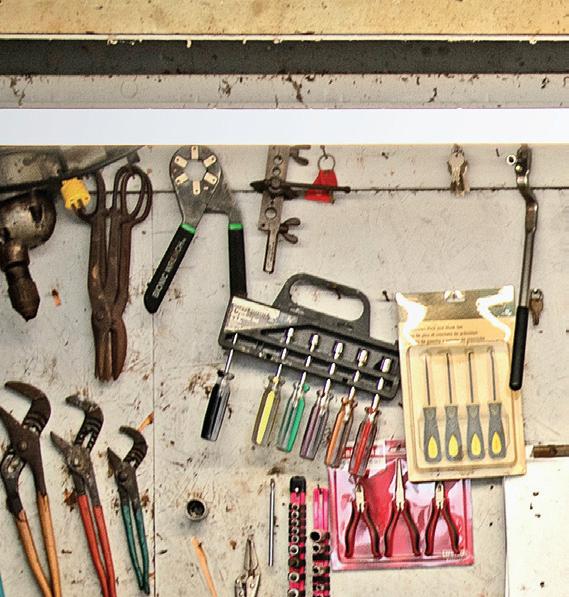
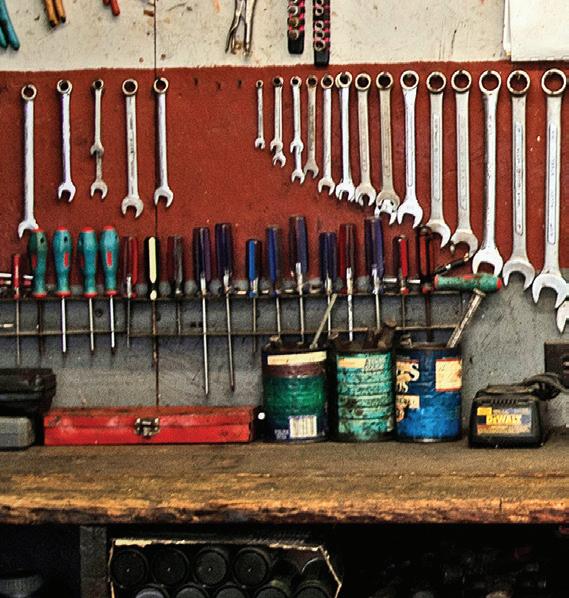
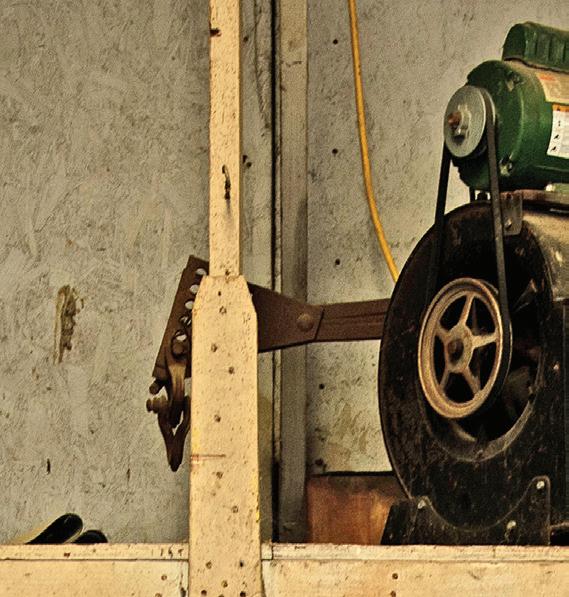


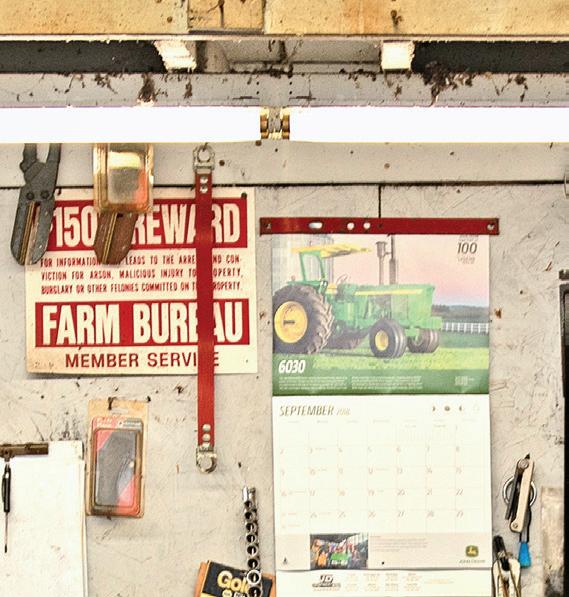
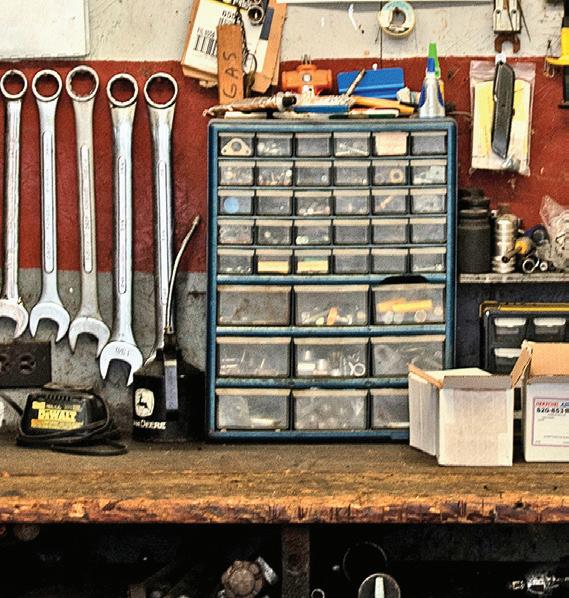
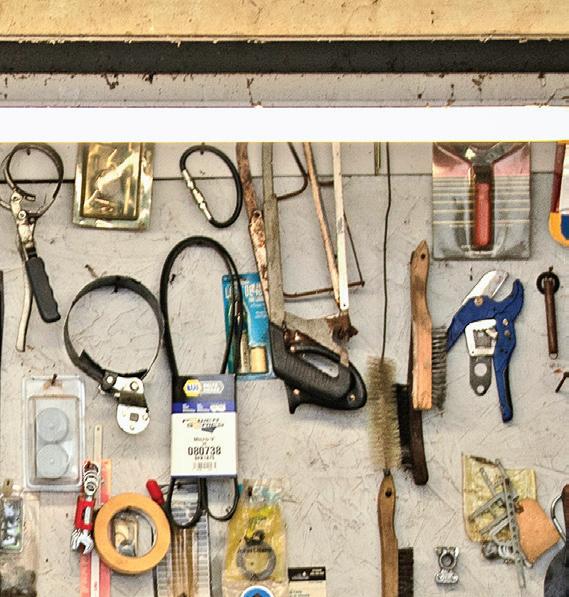
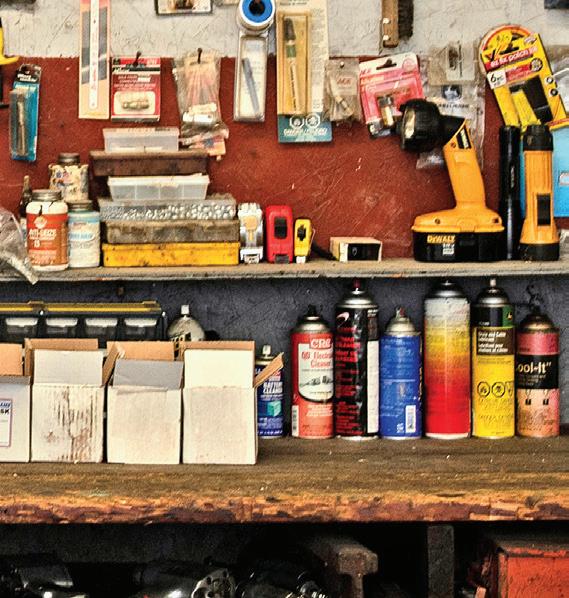
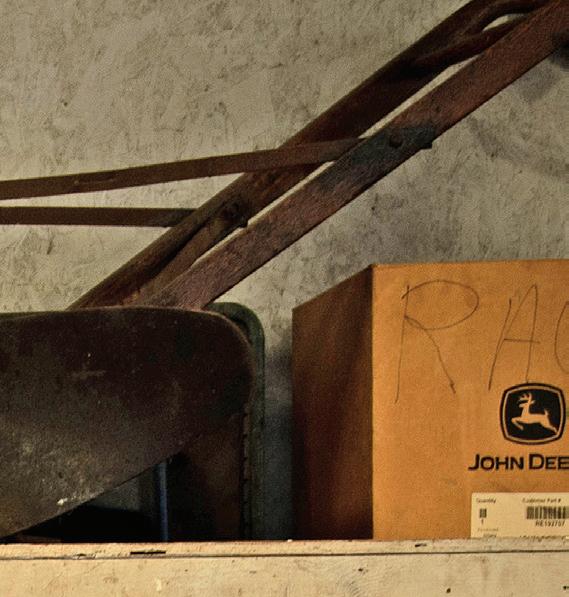


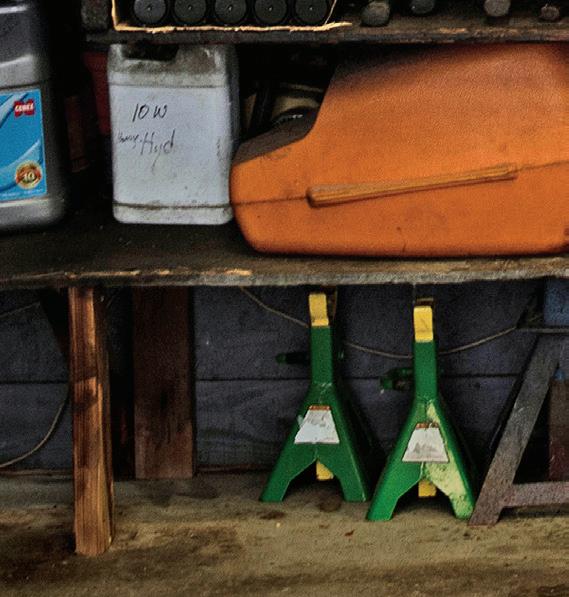
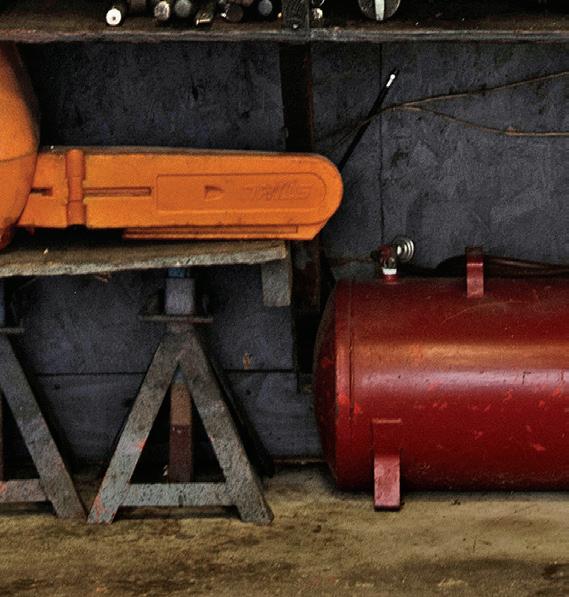




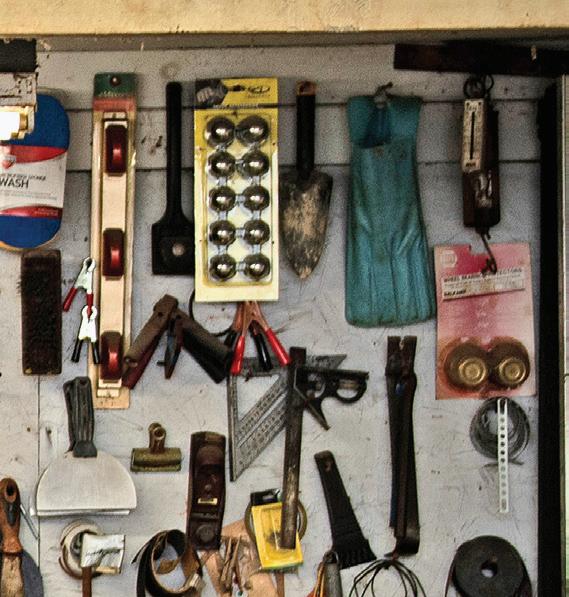
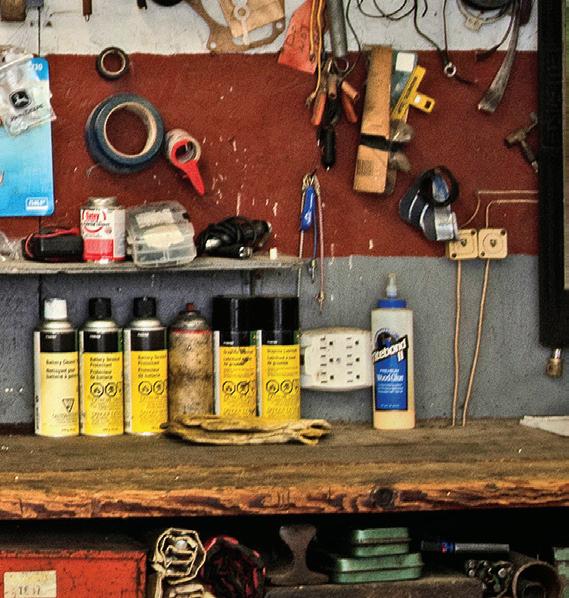

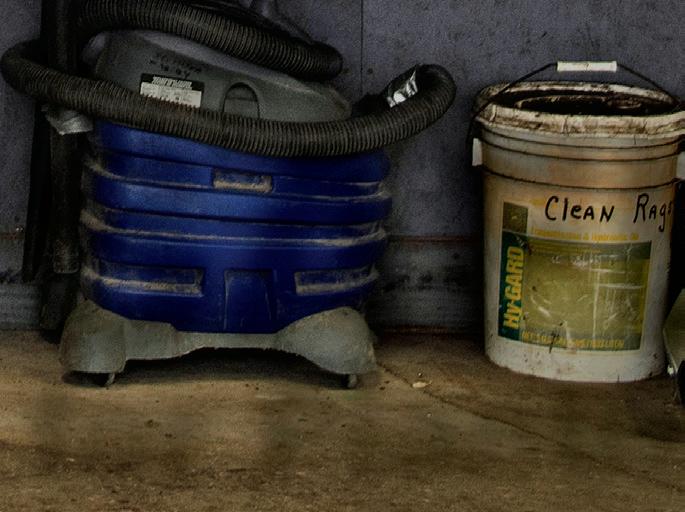




















































Whether it’s improving soybean meal to outperform the competition or promoting the sustainability of U.S. soy, the soy checkoff has been working behind the scenes to help farmers satisfy their customers’ needs. We’re looking inside the bean, beyond the bushel and around the world to keep preference for U.S. soy strong. And for U.S. soybean farmers like you, the impact is invaluable.
See more ways the soy checkoff is maximizing profit opportunities for farmers at unitedsoybean.org






















Scott Metzger
Ohio Soybean Association Chairman Ross County soybean farmer
Advocacy is hard. It’s a time-consuming process that requires a tremendous amount of patience and focus on the end goal. But for many, serving a community they love and a cause they believe in is worth it.
Bret Davis, Ohio Soybean Association (OSA) and American Soybean Association board member, has served as an advocate for our industry for many years and was recently featured in Ohio media talking about advocacy. That article is republished in this issue and I encourage you to read about what he’s helped us accomplish.
Additionally, in this issue you’ll read about the updated policy priorities of OSA and the newly elected Ohio administration. Gov. Mike DeWine has his cabinet members in place and I am optimistic that we’ll have a good working relationship on many issues, including water quality.
Trade and market access are still major priorities for us and will continue to be until the trade dispute with China is resolved. I recently watched an excellent webinar hosted by the Ohio Soybean Council and soybean checkoff that featured Ben Brown, Program Manager of the Farm Management Program at The Ohio State University. He talked about the current trade situation and how it’s affecting the soybean markets now and its potential effects into 2020 and beyond. You can view the webinar at www.soyohio.org/ for-industry/soy-tomorrow
Have a safe and productive planting season.

Scott Metzger
President
Scott Metzger, Ross County
First Vice President
Ryan Rhoades, Marion County
Vice President
Patrick Knou , Shelby County
Treasurer
Jennifer Wilson-Oechsle, Van Wert County
Secretary Je McKanna
Chairman
Allen Armstrong, Clark County
Trustees
Jerry Bambauer, Auglaize County
Trish Cunningham, Knox County
Bret Davis, Delaware County
Rusty Goebel, Williams County
Caitlyn Heimerl, Industry A liate Ex-O cio
Je Magyar, Ashtabula County
Derek Reusser, Holmes County
Je Roehm, Highland County
Luke Ryan, Lucas County
Andy Stickel, Wood County
Kerrick Wilson, Preble County
American Soybean Association
Board Representatives
Jerry Bambauer
Bret Davis
Scott Metzger
Staff Credits
Kirk Merritt-Publisher
Jennifer Coleman-Editor
Julia Brown-Contributing Editor/Sta Writer
Jen Del Carmen - Contributing Writer
Kayla Weaver - Contributing Writer
Brent Warren - Art Director
Barry Falkner - Photo Quality/Proofer
Tony Green - Advertising Production
Ohio Soybean news is published six times a year by the Ohio Soybean Association, 918 Proprietors Rd., Suite A, Worthington, OH 43085. Phone: 614-476-3100. For address corrections contact Ohio Soybean News at 918 Proprietors Rd., Suite A, Worthington, OH 43085.
Web address: www.soyohio.org
E-mail: cdeboard@soyohio.org
Comments and statewide news articles should be sent to the above address. Advertising space reservation must be made by the rst of the month preceding publication. In consideration of the acceptance of advertisement, the agency and the advertiser must, in respect of the contents of the advertisement, indemnify and save the publisher harmless against any expense arising from claims or actions against the publisher because of the publication of the content of the advertisement.
For Advertising Sales Contact:
Matt Herman- (612) 812-5833 matt.herman@dtn.com


Governor Mike DeWine
Although Governor Mike DeWine is new to the governor’s office, he is not new to government. DeWine has served over 40 years, from a prosecutor in Greene County to Ohio state senator to U.S. Representative to Ohio lieutenant governor to U.S. senator. Most recently, DeWine served as Ohio’s Attorney General from 2011 till his inauguration as governor in January 2019.
Growing up, DeWine’s family owned a seed business in Greene County. He has carried on that entrepreneurial spirit into his own career — he is the part owner of three companies that own nearly 1,000 acres of farmland, stocks and even a minor league baseball team in North Carolina, the Asheville Tourists. He still lives on a farm near Cedarville.
By Julia Brown
In general, DeWine is seen as a good governor for agriculture. His campaign promised to “keep taxes low and limit regulation that kills job creation.” As Attorney General, he successfully prosecuted a Huron County man who pleaded guilty to multiple charges related to the theft of more than $3 million in grain from 35 Ohio farmers.
On water quality, DeWine has said in the past that agricultural community needs to be a part of the conversation when finding a solution to the Lake Erie algal bloom problem. According to DeWine, solutions must be datadriven and supported by the necessary scientific research.
Additionally, DeWine plans to address one of the Ohio Soybean Association’s policy priorities for 2019: rural access to broadband.

Lieutenant Governor Jon Husted Jon Husted currently serves as Ohio’s Lieutenant Governor, but his time working in Ohio government is almost as involved as his running mate. Previously, Husted served as the Secretary of State from 2011–2019. He also served in both chambers of the Ohio State legislature as a state representative from 2000–2008 and as a state senator from 2008–2010. He was the speaker of the House from 2005–2009.

When he was still Lt. Gov.-elect, Husted attended the 2018 Ohio Grain Farmers Symposium, which is put on by OSA and Ohio Corn and Wheat Growers Association. At the meeting, he said that the DeWine-Husted administration plans to work with agriculture on issues like water quality, stating, “We don’t want to have an adversarial relationship — we want to have a collaborative relationship.” Husted talked about other ways to uplift rural Ohio. “We want to make sure workforce and training opportunities are available to everybody in Ohio,” he said. “We also want to extend broadband to make sure that no matter where you live in Ohio you have access to the technology highway that broadband presents and creates for everybody."
Director of the Ohio Environmental Protection Agency Laurie Stevenson Gov. DeWine appointed Laurie Stevenson to serve as the Director of the Ohio EPA. Stevenson worked as Deputy Director for Business Relations at the Ohio EPA, where she worked



to help coordinate permitting activities, including complex projects requiring multiple permits. Stevenson has worked at the Ohio EPA for more than 20 years.
Director of the Ohio Department of Agriculture Dorothy Pelanda Dorothy Pelanda was appointed as the new Director of ODA by Gov. DeWine in January. She is the first female director of agriculture in Ohio’s history. Prior to working as Director, Pelanda served in the Ohio State House of Representatives, representing District 86, which includes Union and Marion counties. She served as majority floor leader, majority whip and assistant majority whip.
Pelanda has been endorsed by the Ohio Farm Bureau, the American Conservative Union, the National Rifle Association, the Ohio Chamber of Commerce, the Ohio Manufacturers Association and the National Federation
of Independent Businesses for her legislative work. Before working in government, Pelanda worked as a lawyer in central Ohio.
She grew up on a farm in Union County, although her father worked as an attorney and later as a judge so the family rented out the land to a local farmer. Pelanda and her husband still own 18 acres of her family’s original farm. Already, Pelanda has had an impact on Ohio agriculture. With her at the helm, ODA changed the status of the watersheds in distress rules proposed by former Governor John Kasich in the Register of Ohio to “To Be Refiled.” This means that the proposed rule change “has been temporarily removed from [Joint Committee on Agency Rule Review] consideration by the rule-filing agency.” This means that JCARR will not consider the proposed rule until ODA takes further action.
The Ohio Soybean Association looks forward to working with this new administration to strengthen agriculture throughout the state of Ohio. u













Whether shipping by river, road or rail, the soy checkoff is committed to ensuring America’s infrastructure is a significant advantage for U.S. soybean farmers. We’re looking inside the bean, beyond the bushel and around the world to keep preference for U.S. soy strong. And it’s helping make a valuable impact for soybean farmers like you.
See more ways the soy checkoff is maximizing profit opportunities for soybean farmers at unitedsoybean.org





The Ohio Soybean Association (OSA) strongly supports implementation of the 4R concept of nutrient management — Right Source, Right Rate, Right Time, Right Place.
Supports policies backed by science and research-based discoveries that create practical regulations and avoid undue financial burdens.
Supports allowing current policies and regulations the time needed to achieve expected outcomes.
Opposes any attempt by the state or legislature to regulate commercial fertilizer.
Ohio Department of Higher Education: Supports full funding for Land Grant Universities, including the Ohio State University Extension, the Ohio State University. Agricultural Research and Development Center, and the Sea Grant and Stone Laboratory at Lake Erie.
Ohio Department of Natural Resources: Supports funding for the Clean Lake Erie Fund and continued funding to be utilized for feasible practices to reduce phosphorus in Lake Erie.
Ohio Department of Agriculture: OSA supports the funding the Department needs to fulfill their required duties.
Fuel Quality Standards Funding: Supports full funding for the development and implementation of a fuel quality standards program.
Ohio Department of Education: Supports agriculture education programs in and outside of the classroom.
Supports efforts to increase broadband access to rural Ohio in order to help improve quality of life and create strong and competitive farming operations.
Supports trade and vocational education
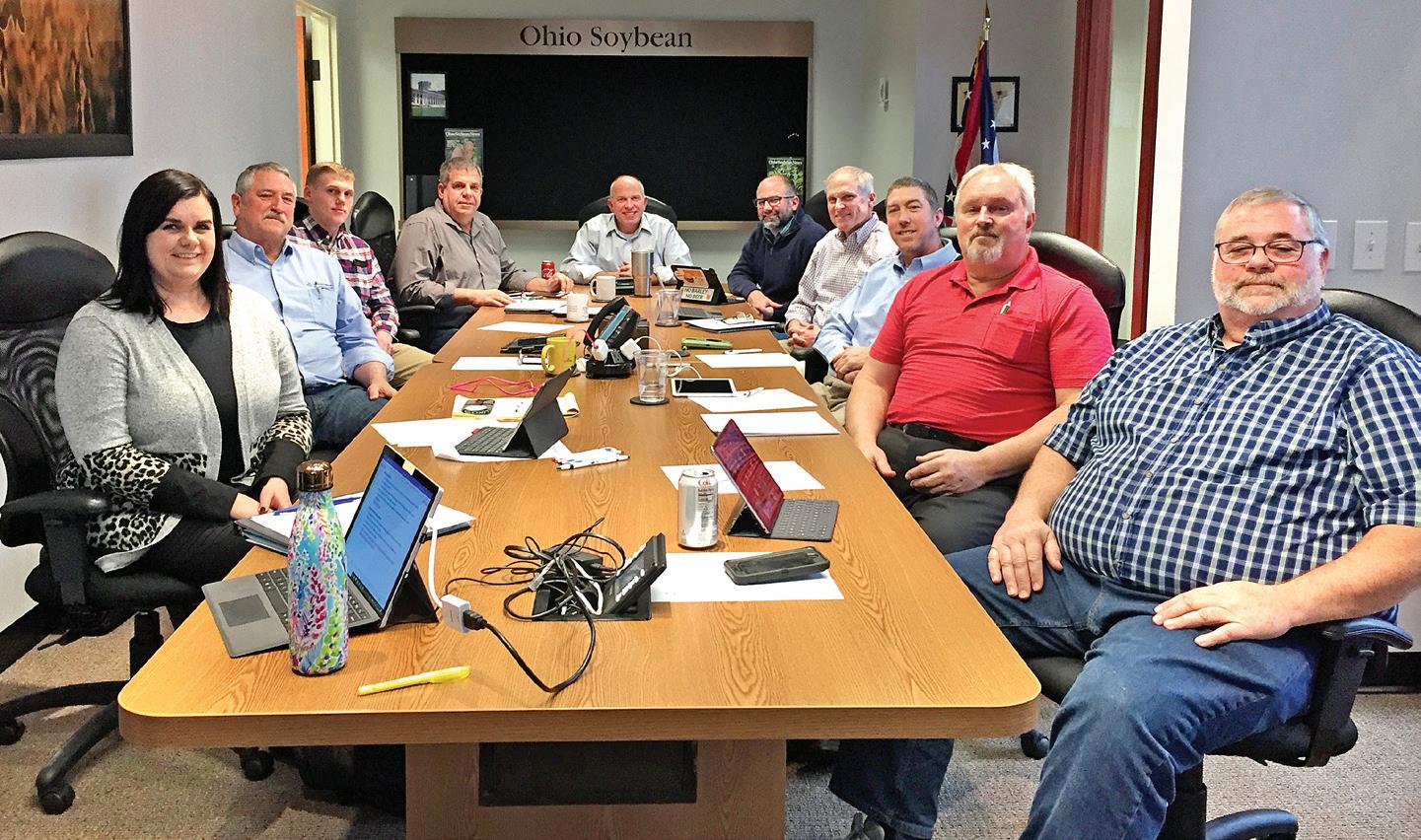
that promotes agribusiness jobs.
Supports efforts to increase access for energy and infrastructure projects in rural Ohio.
Supports the usage of sustainable biodiesel by state vehicles and heavy equipment and encourages the Ohio Legislature to explore the impact of a biodiesel requirement or incentives on all fuel sold in Ohio.
Supports a minimum 10% biodiesel requirement in diesel fuel.
Supports and encourages the increased purchase and use of sustainable biobased products by state agencies.
Supports fuel quality standards to protect consumers from unknowingly purchasing substandard fuel to maintain the integrity of the fuel supply and protect the reputation of biodiesel as a high quality, high performing fuel.
Supports timely and consistent inspections of bridges in rural areas, and adequate funding for bridge maintenance.
Supports higher truck weight limit
OSA’s Policy Committee members got together in late January to determine 2019’s policy priorities. (left to right) Policy Committee Chair Trish Levering, Jerry Bambauer, Derrick Ruesser, Jeff Magyar, OSA Vice President Patrick Knouff, OSA President Scott Metzger, OSA Executive Director Kirk Merritt, Kerrick Wilson, Rusty Goebel, and Bret Davis.
implementation when research shows that increased limits are appropriate due to modern equipment and technology.
Supports resources allocated toward the upgrade of inland water systems and harbor management.
Encourages the state of Ohio to develop funding specifically for attracting and promoting food and agricultural companies to Ohio.
Encourages funding for beginning farmers through young farmer incentives such as loans from banks, farm credit associations, and other sources.
Encourages the State of Ohio to promote soybean markets, both domestically and abroad, through state officials and agency involvement.
Q: Why is it important for an organization like OSA to have policy priorities?
Emilie: Prioritizing policies sets the tone for the year, gives clear direction for where the organization is going and how it will represent its members. There are so many different areas that we could focus on but sitting down and really thinking about what can be done in a year helps us be more effective, by choosing what we really want to support or oppose. More than 500 bills can be introduced during one legislative cycle, so narrowing the scope gives us direction.
Q: How does the board come up with its policy priorities?
Emilie: The OSA policy committee meets and reviews last year’s priorities to evaluate what was accomplished and what still needs work. They also consider other things that may have been an issue in the past that they can

Trish Cunningham OSA Policy Committee Chair
Q: Going into planning the new policy priorities, what were some issues you wanted to make sure to address in 2019?
Trish: Water quality is our top priority and making sure that we are working on behalf of Ohio’s soybean farmers to ensure that we are represented in the discussions. Rural broadband is another top priority for not only us, but also the legislature. This is a budget year, so we will certainly be engaged in making sure our most important issues are funded appropriately.
Q: What priorities are you most excited to work on this year?
work on in the upcoming year. The committee members reflect on what OSA members have faced the past year and ways that it can be improved. They discuss the priorities as a committee, then once the committee is okay with these, they are approved by the full board. OSA staff worked to implement this directive by monitoring and tracking legislation that’s introduced and as it makes its way through the legislative process.
Q: What events in 2018 helped shape the priorities for 2019?
Emilie: 2018 was a tough year for Ohio’s soybean farmers in many ways, with challenges like tariffs and the threat of new regulations on farmers without farmer input. The good news is that is seems like leaders in both the legislative and executive branches are ready to work with farmers to resolve these issues in 2019. While both water
Trish: I am most excited to work on establishing fuel quality standards to protect consumers from unknowingly purchasing substandard fuel to maintain the integrity of the fuel supply and protect the reputation of biodiesel as a high-quality, high-performing fuel. Ohio is one of only three states in the country that do not have a fuel standard. It is important for Ohio consumers to know what is in the fuel they are putting in their vehicles. Along with establishing a fuel standard for the state it allows us to further continue to pursue increasing the usage of biodiesel in Ohio, which is an exciting way to increase soybean usage in Ohio while adding value to a bushel of soybeans.
Q: How has the new administration shaped what OSA will do in the upcoming year?
Trish: It is always an exciting but challenging time with the changing
quality and trade continue to be top priorities for OSA, we’re also looking forward to working on issues like increased broadband access and bridge and road maintenance.

Emilie Regula Hancock OSA Membership and Policy Coordinator
Q: What effect does a new administration have on OSA’s priorities?
Emilie: A new administration affects what issues we work on and how we tackle each one. A new administration brings its own new priorities and style of leadership. Governor DeWine has made it clear that working with agriculture on the water quality issue will be a priority for him and his staff, along with the issue of rural broadband. u
of an administration, but we are looking forward to working with Governor DeWine and his team on our priority issues. We have worked to build a strong relationship with the administration, including Ohio Department of Agriculture Director, Dorothy Pelanda.
Q: How do you see rural development and job/economic development playing a role in OSA’s plan for 2019?
Trish: Our rural communities are losing population. Young people are leaving rural areas for different opportunities in more urban areas. In order to continue to have our farms and rural agribusiness thrive, we need to invest in our communities. Rural broadband, supporting trade and vocational education and to have access to energy and infrastructure are all ways that will help our rural areas remain viable for the future. u


Signing up for or renewing an Ohio Soybean Association (OSA) membership has never been easier. OSA has started using MemberClicks, an online membership management software, to streamline and organize memberships. OSA’s portal on the site is now up and running, so here is a walkthrough explaining how to get started using MemberClicks for your OSA membership.
1
To access OSA’s MemberClicks portal, visit www.soyohio.org/ association/membership. There you can also view benefits for the different membership levels. At the top of the page, click either join now or renew. If you do not need to join or renew, you can visit the site directly at osa.memberclicks.net
2
If you are an existing user, enter your credentials and log on to the site where you can manage your membership. If you are a new user, start by entering your email address and creating a password.
3 You’ll be asked what type of membership you want to have (one-year, three-year or lifetime).
4
You’ll be asked to fill out basic information like your name, farm or company name and address. It is important to note that this information is kept privately and not shared with any other company or organization.
5
Then you’ll fill out some information about yourself, including your areas of interest at both the state and national levels and how many acres of soybeans you farm. After that, you’ll be able to review all your information to make sure it’s correct.
6
One exciting change with MemberClicks is the option to pay online through the OSA portal. You also have the option to pay by phone or through an invoice, if you would like to. OSA handles sending membership dues to the American Soybean Association for your national membership.
7 After you have paid, you will have access to the Members Only Area where you can make changes to your profile, select how OSA communicates with you and update/renew your membership.
The process to renew your membership is almost identical, but you will not have to set up an account. If you are currently an OSA member who does not need to renew, you should already have an account with MemberClicks. If you do not, or you’re not sure how to access your account, feel free to contact Emilie Regula Hancock, OSA’s policy and membership coordinator at 614-476-3100 or eregula.hancock@soyohio.org u
www.soyohio.org/association/membership
























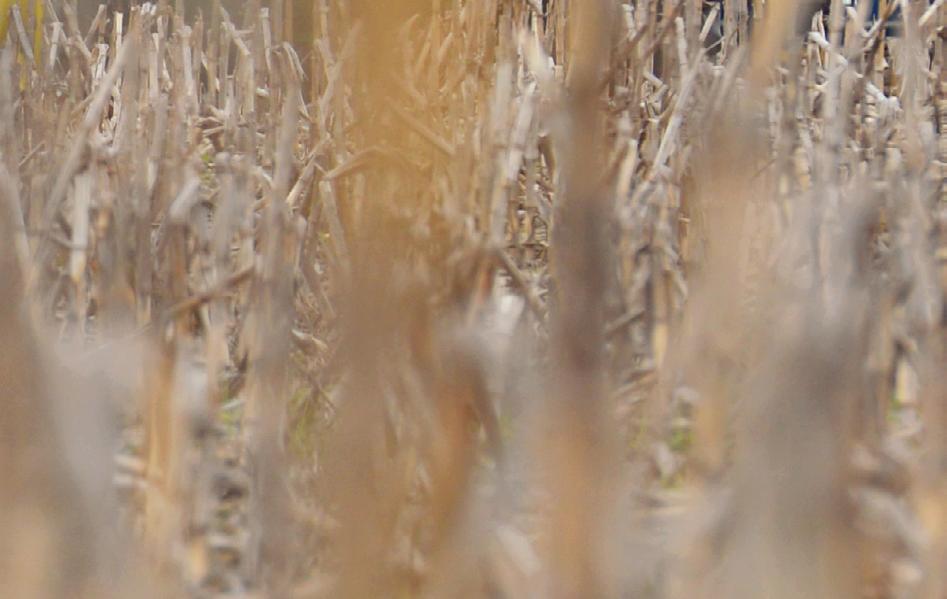








and their checkoff. Whether you’ve been planting soybeans for years, or you’re just starting out, the Ohio Soybean Council is investing in projects designed to help you maximize earnings on your farm now and for generations to come. From yield research to creating demand, your checkoff dollars are working hard for you. To learn about what the Ohio Soybean Council is doing for you, visit soyohio.org
soybean


By Chris Kick, Farm and Dairy
The time that Delaware County grain farmer Bret Davis spends speaking on behalf of soybean growers is no doubt a benefit to his own operation.
As one of two partners on a 3,500-acre farm, anything he can do to increase demand helps with his own business.
But for Davis, who has spent at least a dozen years on the Ohio and American soybean associations, the reward is what he is able to do for all producers, from one corner of the country to the other.
“I have a passion for what the soybean industry and farmers are doing,” he said. “I don’t do this for myself — I do it for all of the farmers here (in Ohio) and in the United States.”
In December, Davis was elected secretary of the American Soybean Association, where he helps with records and minutes, and reaching out to lawmakers and federal regulators.
Davis farms with his stepson, Wade McAfee. The two manage a grain farm that is now in its sixth generation. Davis and his wife, Janie, have seven adult children between them, and nine grandchildren, with another on the way in March.
Davis grew up farming with his father and uncle, and his family traces their roots in the area to the 1800s, when they emigrated from Wales. Family is important to him, and he wants to see the operation continue.
“That’s why I do this,” he said. “It’s not for me or anybody else — it’s for longevity.”
In 2018, he led the farm bill task force for the American Soybean

Association, where he helped to tell federal lawmakers about the importance of crop insurance and farm safety net programs. Judging by the most recent farm bill, signed by the president in December, Davis said it’s obvious that lawmakers listened and took farmers’ concerns seriously.
He said crop farmers did not get everything they wanted, but thanks to their voice, farmers ended up with “a workable bill” that satisfies most of what they needed.
“I think they (lawmakers) listened to us,” Davis said. “When you get 60-70 farmers to go to D.C. and spend their day in the Capitol and make those connections, it really makes a difference.”
Davis said the last five or so years have especially been good for the soybean association, and today when lawmakers have a question or want to know how farmers across the country feel, they call the association to ask.
“To have that two-way conversation — it goes a long way,” he said.
Ryan Findlay, CEO of ASA, said that Davis is a good listener who tries to look at both sides of an issue before making a decision.
“He considers the on-the-ground application of policy decisions, not for himself but for farmers around the nation,” Findlay said. “It’s an incredibly selfless act, and it’s this type of leadership style that makes us so effective as an organization.”
At his own farm, things are always changing, whether it’s a new farming practice, a new piece of equipment or something bigger. Davis just recently sold his seed business and home, known as Bret Davis Seeds, to a young couple in the area, who were looking for a new opportunity.
Davis said it allows someone local to carry on the seed business, and he’s confident the buyers have the ambition to keep it going.
With his own place sold, he’s in the process of building a new house, just a short distance down the road from the seed business.
Davis Farms has seen many other changes over the years, and at one
time included a beef and feeder cattle operation. However, when the meat packing industry moved out of the area, Davis said it no longer seemed economical to keep feeding beef.
Today, the farm is exclusively a crop operation, and that alone has seen its share of changes. The farm went from tillage to mostly no-till, and continues to evolve with new conservation practices and precision planting, as well as precision nutrient application.
“I say we’ve got a 3,500-acre test plot because we’re always testing something against the other,” he said.
In the past, Davis would spread fertilizer in the winter, when conditions would allow. But with the changes in nutrient management and water quality, he now tries to target a growing crop, and he also plants about 2,000 acres of cover crops to improve organic matter and keep nutrients and soil in place.
The changes aren’t always easy, he said, but in the long run, they make economic sense and they’re better for the environment.
This past year, conditions were so wet that Davis and many area farmers had fertilizer applied by aircraft because fields were too wet for land equipment, and the crop was too tall.
Davis has been a certified crop adviser since 1990, and is a regular at area nutrient meetings and training events.
“I’m always trying to learn,” he said. “You’ve got to keep on learning, to understand how to fix things.”
One of the biggest things farmers like Davis are trying to fix is nutrient runoff. While they may not be able to stop it completely, Davis said it’s a priority issue, whether the water is flowing north, into Lake Erie, or south, to the Ohio River.
But he said change takes time, and it’s important to study the science behind what is happening, so the right changes get made. He complimented farmers who are taking part in edgeof-field studies, to determine how much nutrients are leaving fields, and the best solutions.
An ongoing issue for Davis and the soybean association is developing more
markets. Although the U.S. lost a lot of market share with the current trade war with China, Davis said he’s optimistic about some of the new agreements being made with countries like India, Singapore and South Africa.
One positive thing about the dispute with China, he said, is that both countries now understand how reliant each is on the other, and he hopes there will be new opportunities with China going forward.
In the meantime — regardless of where prices are at — Davis said farmers need to develop a solid marketing plan and think in advance. For his own farm, that means marketing as far as three years out, and maintaining good on-farm storage and delivery.
“Everybody knows how to grow a crop, but it’s how to market a crop that makes the difference,” he said. u
Farm and Dairy, based in Salem, Ohio, is a weekly newspaper centered around the rural community featuring coverage on agriculture, rural life, market reports, auction listings, classifieds, shale gas news and much more. Find more articles like this at FarmandDairy.com

Installing field tile.
Photo by Chris Kick


Many people don’t discover their career path until they get to, or even after they graduate college, but some have had it figured out from day one. That’s often the narrative for those in agriculture and certainly the case for Darby Walton. Darby graduated from OSU in 2016 with a degree in agribusiness and a minor in production agriculture. After graduation, he returned to his hometown of Sycamore, Ohio, to work on his family’s farm.
“As an eighth-generation farmer, I have really strong agricultural roots,” said Darby. “I really care about preserving the farm because it’s been in my family since the late 1780s.”
Darby lives in a large, Victorian brick home his family calls “The Homestead” that was built on their property by his great-great grandfather in 1884. His family farms 750 acres of corn, soybeans, wheat and hay and also raises beef cattle, but the farm isn’t the only family legacy Darby is carrying on. He is also a third-generation auctioneer following in the footsteps of two Ohio Auctioneer Association Hall of Fame members, his dad and grandpa. He travels yearround to auction off farm machinery and farmland, and sell at benefits and household sales. His grandpa started the auction business in 1951 and Darby, his dad and a few other employees have kept it going ever since.
“When I was a kid, some of my favorite memories were riding to sales with my grandpa,” said Darby. “Auctioneering is something that’s always been in my blood.”
The farm and auction businesses go hand-in-hand and keep Darby and his father very busy. Darby travels to nearly 100 sales every year while maintaining the farm and also working as a John Deere salesman.
“Working for John Deere has been a great networking opportunity that has helped me get to know other farmers,”
explained Darby. “It has also helped in developing my sales and negotiation skills, which are really important as an auctioneer.”
Darby wears many different hats, but each carries a special meaning. With so



much family history intertwined into his career, his passion for agriculture goes beyond nurturing plants from planting to harvest. Preserving the land and the family businesses for future generations is a top priority.
The Walton family uses conservation strategies to protect their soils, land and local waterways. For example, they use buffer strips, which are areas of vegetation planted to prevent erosion, control soil and water quality and prevent nutrients from leeching from the fields into local creeks and streams. They also use cover crops, like turnips or radishes, planted to protect and enrich the soil between growing seasons and then cleared away in the spring.
“There’s a lot of pride that goes into being a multi-generational farm and not just because my family has been doing it for years,” said Darby. “It’s something that’s very meaningful to me personally. I really love what I do, and I can’t imagine a day without it.”
Managing a successful farm goes beyond driving tractors and combines. As he grew up on the farm, Darby was
Eighth-generation farmer Darby Walton knew he wanted to work on his family's Wyandot County farm long before going to college.
introduced to the back end of the business as he gained more responsibility.
“There’s so much more that goes into farming than just sitting in a tractor,” said Darby. “There’s a lot of financial planning and book work that most people don’t think about. Input costs are extremely high compared to the dwindling prices that farmers get, so thorough planning is key.”
Whether they’re the first in their family or the eighth generation like Darby, Ohio farmers do what they do because they have a love for their land and the things they grow. Doing what’s best for their crops, animals and families is their number one goal. u
This story originally appeared on Future Eats. Future Eats, funded by Ohio soybean farmers and their checkoff, is the Ohio Soybean Council’s consumer outreach program targeting non-agriculture students at The Ohio State University. You can read more stories like this one at FutureEats.com.


What is the difference between the United Soybean Board and the Ohio Soybean Council?
–A soybean farmer in Putnam County Soybean farmers collectively invest a portion of their product revenue (0.5 percent of the market bushel price) to fund research and promotion efforts. This collective investment is called a checkoff. The soybean checkoff was established in the early 1990s to facilitate soy market development through research and commercialization programs. Checkoff funds cannot be used toward legislative or policy activities.
While some commodity checkoffs are governed by individual states, like the Ohio Corn Checkoff, the soybean checkoff is national. Checkoff dollars are collected by each state’s checkoff organization, known in Ohio as the Ohio Soybean
Council (OSC). Half of the money stays in Ohio and half of the money goes toward the national checkoff. At the national level, the checkoff is directed by the United Soybean Board (USB), which is made up of 73 volunteer farmer-leaders. These farmer-leaders serve on their statelevel checkoff organizations, like OSC, and are nominated to serve on USB. To put it simply, OSC directs the checkoff funds that stay in Ohio, and USB directs the funds that are collected nationally.
The United Soybean Board also differs from another national soybean organization, the American Soybean Association (ASA), in the same way that the Ohio Soybean Council differs from the Ohio Soybean Association (OSA). ASA and OSA function more like traditional trade

associations, which are membership driven and help advance the soybean industry’s interests in legislation and policy. Checkoff funds from USB and OSC cannot be used for legislative activities. u
We polled our Twitter and Facebook followers: Based on the knowledge I have right now (before USDA reports were released) I'm planning to plant acres of soybeans in 2019.
"About the same"
Have a question about the checkoff or soybeans in Ohio? Write to us at jbrown@soyohio.org.
While it can be tempting to eat sugary snacks during those long planting days, these No-Bake Dark Chocolate Protein Bars are a much healthier alternative that taste just as good. Plus, the soy protein will help keep you fuller longer.
Ingredients
1 cup soynut butter
1 cup honey
2 cups quick oats
1 cup of dark chocolate chips
1 cup dried cranberries or raisins
1 cup milled flaxseed
1 cup vanilla soy protein powder
Directions
1. Using an electric mixer, combine soynut butter and honey. Add remaining ingredients one at a time, scraping sides after each addition, until evenly combined. Mixture will be very stiff.
2. Press mixture into a 9 x 13 pan and refrigerate until ready to serve.
3. Cut bars and store in refrigerator for up to one month. u
Source: Future Eats



By Jen Del Carmen, USSEC
With so much media attention on how tariffs have affected soybean trade to China these days, it’s easy to overlook the importance of the combined European Union (EU) / Middle East North Africa (MENA) market.
The EU/MENA region represents the second largest global export soy market, trailing only China. With a combined population of 960 million, this market is vital to the U.S. Soy industry. Let’s take a quick look at both of this market’s sectors.
“The Europe and Middle East/North Africa market has been a bright spot for U.S. Soy exports this marketing year,” says Brent Babb, Regional Director – EU/MENA for the U.S. Soybean Export Council (USSEC), “as soy exports to the region are up 140 million bushels over last year at this time.”
This represents a 210 percent increase in whole soybeans and a 17 percent increase in soybean meal exports for the U.S. Soy industry.
Countries with largest bushel increases this marketing year include Egypt (30 million), Spain (23 million), Netherlands (15 million), Italy (12 million), and Portugal (10 million).
The EU boasts a population of 580 million people and represents 27 percent of the world’s gross domestic product (GDP). For comparison, the U.S. GDP is 23 percent.
The European feed industry is growing at a three percent rate, which is also above the growth rate of the U.S. The EU is the world’s largest soybean meal importer, and the market there is highly competitive. There is an increasing valuation for U.S. soybean meal as feed formulation tables value soybean meal by origin.
Particularly in the European market, sustainability is a priority. USSEC, the international marketing arm of the U.S. Soy industry, continues to help make it a key differentiator and a competitive advantage.

In 2013, USSEC responded to customer requests for a supply of documented and certified sustainable soy by using a multistakeholder process to involve buyers, sellers, associations, and government agencies to create a certification system, developing the U.S. Soy Sustainability Assurance Protocol (SSAP), which certifies shipments of U.S. Soy as sustainable based on a national system of sustainability and conservation laws and regulations combined with careful implementation of best production practices by U.S. farms. The SSAP describes the regulations, processes, and management practices that ensure sustainable soybean production. In addition to addressing how sustainable performance by U.S. soybean farmers is measured and verified by various government programs, the SSAP also offers exporters of U.S. Soy the ability to obtain an official sustainability certificate. The SSAP is positively benchmarked against the European Feed Manufacturers’ Federation’s (FEFAC) Soy Sourcing Guidelines through the Independent International Trade Centre (ITC) benchmark tool, which helps U.S. Soy gain acceptance on a level playing field.
The U.S. Soy industry recently took another step in the right direction in the EU. On January 29, the European
The U.S. Soy delegation at the port of
Commission recognized the acceptance of the SSAP-RED as a voluntary scheme under the Renewable Energy Directive (RED), which establishes an overall policy for the production and promotion of energy from renewable sources in the EU. This recognition allows soybean oil from SSAP-RED certified soybeans to be used as feedstock for biodiesel production in the European Union.
“The European Commission’s recognition of SSAP-RED is yet another breakthrough for U.S. Soy in the European and global markets,” states Babb. “It will continue to boost opportunities for U.S. soybeans and keep us moving forward.”
The RED restricts the production of biofuel feedstock from land that has been converted to agricultural production from the designated land categories of wetlands, including peatlands, grasslands and forest. The U.S. has had similar limits on land conversion for over 30 years since the 1985 Farm Bill. The SSAP-RED goes further than the existing SSAP in having a system of third-party auditing and compliance, supporting all aspects of the scheme.
With a population of 380 million, MENA represents 6 percent of the global population. Although there are widespread security concerns in this region, conflicts are decreasing. Infrastructure hurdles have also presented some issues, but investment is ongoing.
Although the region presents these challenges, crush capacity is continuing to increase, particularly in Egypt, Saudi Arabia, Algeria, and Lebanon. Through investment, the animal ag industry is growing, and the feed, poultry, dairy, and aquaculture industries are increasing their business as the region stabilizes.
Egypt is the region’s largest importer of U.S. Soy, followed by Saudi Arabia, Tunisia, Morocco, and Israel.
U.S. Soy has an excellent opportunity in Egypt for aquaculture, as technology for intensive pond raceway systems has been adapted there. There are additional prospects in North Africa and the Gulf region on a smaller scale.
Other opportunities for U.S. Soy in the region include an increase in soy extrusion, growth in regional soybean oil refining, chances to increase soybean oil in feed formulations, and strong Saudi poultry and dairy industries providing opportunities in by-pass meal exports.
Because the trade war between the U.S. and China has affected global trade, the U.S. Soy industry has looked to maximize opportunities through its “What it Takes” initiative, assembling projections in other global markets to mitigate volume losses to China. This initiative aims to maintain the level of U.S. Soy exports, approximately 60 percent.
To accordingly capture trade flows to EU/ MENA, USSEC moved up its annual spring buyers’ conference in the EU/MENA region to November 2018. The regional trade exchange, held in Barcelona, Spain, provided a vital opportunity to connect top EU/ MENA purchasers with U.S. exporters and grower leaders with the goal of promoting U.S. Soy, developing or further enhancing relationships, and leading to a preference for U.S. Soy, while increasing purchases.
Ohio Soybean Council director Bill Bayliss, a soybean farmer from Logan County, was in attendance at the Barcelona event.
Bayliss explains that in the 2016/17 marketing year, EU imported 4.599 MMT of U.S. Soy. In the current marketing year, current growth is over 100 percent, so the timing to connect with these customers was essential.
About 300 regional decision makers attended. “My role was to form relationships and I am enthusiastic about this,” he says. Bayliss says he made good contacts and had the chance to visit oneon-one with customers.
“We were showing them that [U.S. farmers] are normal people trying to provide them with a good product.”
While Bayliss grows both food and feed grade soybeans, he talks more about his food grade beans in this market and says that much as grapes grown in Napa have a distinct flavor, soybeans grown in Ohio, Indiana, and Michigan have a special taste as well.
After the Regional Trade Exchange, Babb said USSEC had heard from several exporters that the meeting led directly to sales with new customers. DeLong is expected to export 10,000 metric tons (MT) of soybean meal crushed in Ohio to MENA.
In addition to the Barcelona conference, USSEC is continuing a series of special marketing seminars, “Experience Today’s U.S. Soy Advantage.” Three of these meetings took place in the EU during the first week of February in Italy, Spain, and Portugal.
These seminars provide current and potential customers of U.S. Soy with in-depth information about the U.S. Soy Advantage, supporting the “What it Takes” initiative by aiming to raise the awareness of the intrinsic and extrinsic values of U.S. Soy and build a preference for U.S. Soy and soy products with international companies in targeted markets.
Around the world, USSEC is connecting buyers and sellers to encourage a longerterm trading program that extends beyond the typical seasonality as it plans events as part of USSEC’s larger trade mitigation work. EU/MENA is an important piece of this puzzle.


Katie Bauer, OSC global demand and market development coordinator, Bill Bayliss, OSC board member, and Lola Herrera, USSEC contractor for Southern Europe.
While the EU is a mature, long-time U.S. Soy market, it is by no means stagnant. According to a recent Purdue University study, the greatest potential for growth under the current environment is in the EU. While this is being realized incrementally, huge potential remains.
MENA is clearly poised to continue its growth as well. USSEC has earmarked Algeria, Egypt, Morocco, Nigeria, and Tunisia as basic markets, where the U.S. Soy industry strives to introduce world-class technology. USSEC’s international marketing strategy has shifted more funding to invest in these new markets with an increasing emphasis on growing demand in current low consumption areas. u



By Julia Brown
he Old Farmer’s Almanac for 2019 predicts Ohio will experience higher than average precipitation this summer. Of course, it’s almost impossible this far out to predict how much rain will come to the Buckeye State and how it will affect soybean farmers, but one way to prepare for heavy rain is to create a conservation plan.
A conservation plan is a tool for farmers and ranchers to better maintain the natural resources on their land. They differ slightly from nutrient management plans in that conservation plans focus on ways to improve pest management, soil health and yields while reducing energy and input costs, rather than controlling nutrients.

Getting and implementing a conservation plan is completely voluntary, but it has several benefits, including an increased economic return on the operation, improved soil quality and plant production, better weed control, and improved air and water quality.
The first step in getting a conservation plan is to contact a local Soil and Water Conservation District office. There is no cost to create a conservation plan. Services are provided by the U.S. Department of Agriculture Natural Resources Conservation Service in cooperation with a farmer’s local district.
Farmers will be asked to share their crop sequence, or the crops they’re planning to grow in each field. They’ll also need to provide
information about how the land is farmed, what kind of tillage is done with what equipment, and future crop and livestock plans. It is important to remember that conservation plans are protected by the Freedom of Information Act and creating a plan does not provide public access to a farmer’s property or information.
A NRCS conservationist will visit the farm to conduct an in-person fieldby-field evaluation of the soil, water, air, plant and animal resources on the farm. Then he or she will suggest options to address any concerns, with a timeline to introduce those measures. These practices will be recorded as part of the official conservation plan, which is kept confidentially at the NRCS office. If a farmer decides to make changes to the plan based on changes in market, weather or technology, he or she will need to contact the office to make any official changes.
According to the NRCS Ohio website, a complete conservation plan
will include:
A farmer’s determined goals and conservation decisions
Aerial photographs of the land
Soils map, soil descriptions, and other resource inventory data, such as forage or crop production potential
Location and schedule for applying conservation practices and systems
Maintenance information for installed conservation measures
Detailed information on how to carry out specific management decisions.
Ultimately, the timing and extent that a farmer implements a conservation plan is completely up to each individual. Many of the suggested changes, like changing crop rotation or contour farming, often do not require a financial expense, only a change in farming practices. Others, like grassed waterways, might need an additional investment, but many of these costs can be offset through federal, state and local cost-sharing programs. u


Productive soils are key to maximizing soybean yields and farm profitability. Cover crops are a great way to enhance soil health, maintain fertility and improve overall plant performance. With more farmers looking into sustainable ways to enhance their farm management plans, cover crops provide a solid solution.
Alan Sundermeier is an Ohio State University Extension educator in Wood County who specializes in helping farmers start growing cover crops. Through research supported by the soybean checkoff, he’s seen overwhelming evidence of their benefits. This includes farm survey data pointing to potential yield gains.
“By covering the soil when cash crops aren’t growing, cover crops allow farmers to utilize sunlight, water and nutrients that otherwise would be wasted,” explained Sundermeier. “They also help reduce soil erosion through living roots and residue, suppress early spring weed growth and encourage soybean emergence by reducing soil compaction.”
Nate Douridas, farm manager for the Molly Caren Ag Center and the Farm Science Review (FSR), agrees. He and his team began experimenting with cover crops five years ago to protect the soil from erosion and expand conservation efforts. They now have a strong system
that also provides learning opportunities for FSR attendees.
As a farm manager, Douridas knows the cost of planting cover crops. There’s equipment, time, seed and evaluation. That’s why both he and Sundermeier recommend making a plan before sowing the first seeds. Here are their steps for getting started with cover crops.
Talk with an experienced cover crop farmer in your area or attend a local production meeting to learn more about your options. Sundermeier recommends attending the Conservation Tillage and Technology Conference and reviewing these online resources:
Ohio State University Extension Ag BMPs
Midwest Cover Crop Council
Sustainable Agriculture Research & Education Cover Crops Topic Room
Think about your overall goal and how cover crops fit into your cash crop rotation. Consider any new equipment or custom services you’ll need, and don’t forget to develop a plan for termination. A roller/crimper, mower, herbicide, grazing, or tillage can be used to control cover crop growth before or during planting.

Talk with your seed dealer to select the right varieties or hybrids to fit your plan. This may involve choosing an early maturing soybean that can be harvested in September, giving you plenty of time to get back in the field to seed the cover crop.
There’s no need to go big or go home in this situation. Douridas started small with 30-60 acre fields in targeted areas and expanded from there. Sundermeier also recommends planting one field first to understand how to establish and terminate cover crops in your soils, climate and cropping system.
According to Sundermeier, farmers in a corn/soybean rotation can start simply with cereal rye planted in the fall of the corn crop year. Your dealer may also have ideas for cover crop seeds. Douridas started with a basic winter wheat thanks to dealer recommendations. Over time, he’s also planted Lynx variety peas and hairy vetch. Another helpful resource is the cover crop selector tool from the Midwest Cover Crops Council.
Don’t be afraid of wide rows. Douridas said they started with 7.5 inch rows and eventually expanded to 15 inches. Examine your planter attachments to see what’s possible and be open to experimenting.
It may take some time to find the right balance of sustainability and profitability for your farm, but cover crops are worth trying. Now is a great time to do your research and start working on a plan. u
This article originally appeared on Field Leader, an online resource to give farmers access to the latest soybean checkoff research and water quality information to enhance their operations. Find more stories like this one at OhioFieldLeader.com







It would be difficult to bring more than 1,200 students to farms during planting and harvesting season — it’s much easier to bring the farms to them. In 2018, students from around the state used live video conferencing software to ride along with Ohio soybean farmers as they planted, maintained and harvested their crops and worked to improve water quality on their farms.
Students in Ohio and beyond will continue to have the opportunity to connect with farmers in real time in their fields and on their equipment through the Ohio Soybean Council’s (OSC) Virtual Field Trip to an Ohio Soybean Farm program. The success and demand from the program’s inaugural year in 2018 have led to five more scheduled trips for 2019.
“These trips allow students of all ages to investigate soybean production and life cycles, the uses and impact of soybeans, and the practices farmers are implementing to conserve and improve our environment, all live and from the perspective of the farmer,” said Tom Fontana, OSC’s director of research and education. “For many, it’s as close as they’ve ever been to stepping foot in a soybean field.”
The program has received positive feedback from participants. Through survey evaluations, 90 percent of participating teachers said they would recommend the program to their colleagues, and respondents unanimously said they would participate in future virtual trips.
Comments from teacher evaluations indicate that they enjoy the authentic, interactive and informative nature of the live conversations with farmers, while allowing their students to make real-world connections and be “on-site” without losing a whole school day for a field trip.
“The results the first year speak for themselves and surpass what we considered to be ambitious expectations,” Fontana said. In addition to the 1,200 students who participated live, over 5,000 students from

over 200 classrooms had the opportunity to view recorded versions of the trips.
Tailored to specific grade levels, special attention is provided toward helping teachers meet Ohio education standards through the trips, of which more than 95 percent of surveyed teachers said it helped them do.
Wood County farmer Nathan Eckel, Ross County farmer Scott Metzger and Hancock County farmer Anthony Stateler were the faces of the program in 2018, welcoming students and their questions to their farms through their phones and iPads.
“Having the ability to advocate and educate on behalf of our industry while we are in the field working has been an eye-opening experience for all involved, including us farmers,” said Nathan Eckel. “Students and teachers are engaged in the conversation and getting their information directly from us rather than from Google.”
The Virtual Field Trip program is part of a larger effort to educate both teachers and students about modern agriculture.
OSC’s web-based education platform, GrowNextGen.org, has classroom curriculum, e-learning courses and career videos — all designed to educate the next generation of consumers and generate interest in agriculture careers.
The 2019 trip schedule includes:
May 14 – Elementary Spring Planting
6,000 students
May 15 – Middle/High School Spring Planting
Fall – Middle/High School Water Quality & Nutrient Management
October – Elementary Fall Harvest
October – Middle/High School Fall Harvest
For more information, or to register for a Virtual Field Trip to an Ohio Soybean Farm, visit https://grownextgen.org/ virtual-field-trips, or contact Tom Fontana at tfontana@soyohio.org or 614-476-3100.

Using apps on their phones, soybean farmers were able to teach students what it takes to run a soybean farm.


By Julia Brown
At the end of January, the Ohio Soybean Council (OSC) and Ohio Soybean Association (OSA) Boards of Trustees held their annual joint board meeting. The meeting allows members of both boards to come together to learn about the most important issues facing Ohio soybean farmers to help shape how the boards view their respective priorities in the new year. This year’s meeting focused primarily on two topics: water quality and precision agriculture/blockchain.
First, board members learned from both OSC and OSA staffs about the current situation regarding water quality. Water quality presents an opportunity for OSA and OSC to work together indirectly. As staff explained, water quality is seen as a three-legged stool. Two legs — research, which answers important questions, and education/communication which tells the story of water quality — fall to the responsibility of the Council. The third leg, policy/advocacy, is carried out by the Association and often uses the research funded by OSC to ensure regulations are not burdensome and science-based.
OSC funds several research projects with Ohio soybean checkoff dollars that help scientists and farmers alike better understand water quality and nutrient runoff. For a more in-depth look at these projects, please visit www.soyohio.org/council/plantresearch or ohiofieldleader.com. Field Leader is part of the communication leg as well, helping spread knowledge about reducing nutrient runoff and educating farmers about best management practices. OSC has also developed formyfarm.com, a website for both farmers and consumers to learn about the best management practices soybean farmers across the state are using to help manage nutrient runoff.

The Boards also heard a presentation from Scott Shearer, professor and chair of the Department of Food, Agricultural and Biological Engineering at The Ohio State University. Shearer shared about the department’s work involving precision agriculture and about what is in store for the future of ag technology, including a look at one of the buzziest technologies of the past few years: blockchain. Shearer explained how blockchain will help farmers of food-grade and commodity beans keep identity preservation and allow for better trading opportunities as soybeans from Ohio are shipped across
the world. He also explained how the cryptocurrency Bitcoin could be used by farmers in the future.
Shearer also shared how technologies like autonomous machinery and drone precision will help expedite and expand agriculture in the future. If you are interested in learning more about OSC’s work to help farmers navigate purchasing precision agriculture, please visit precisionagreviews.com
The meeting concluded with updates on both organizations by OSC Chairman Steve Reinhard and OSA President Scott Metzger, and a look at what both organizations are planning for 2019. u


By Kayla Weaver
Farmers are faced with a lot of decisions each spring. Deciding on a seed lubricant has typically come down to choosing between the dusty, dark graphite that can easily stain your hands and clothes or the powdery, white talc that could be dangerous if high amounts are inhaled. While both perform the necessary function, neither is a pleasure to work with.
In 2011, Dave Kloostra and Brian Tulley came together to form Low Mu Tech and put a serious effort into formulating an alternative. Their work led them to consider soy protein and after a few years of trials they had a marketable product — Dust (patent pending).

“We wanted a product that was easy for farmers to accept, so we did analysis in the Mid-West, around St. Louis all the way down to the Delta trying to get it into different planters with different tillage practices to make sure it was a seamless fit for the farmers to transition from the graphite and talc products to our Dust product,” said Tulley.
The product was officially launched in early 2018 at Commodity Classic in Anaheim, California. This brought opportunity to have Dust used on acres stretching from Washington state and the Dakotas, through the Midwest, down to the Delta, and over to Virginia. Research trials were also put into motion at The Ohio State University, University of Missouri and the University of Tennessee. This year they’re building the brand by setting up dealers and distributors in key parts of Illinois, Indiana, and Ohio as

well as Iowa, Missouri, and North and South Dakota.
“Dust is not a hammered or milled product — it’s manufactured to produce tiny round uniform particles, which is why it works so well. Dust is 20 times less abrasive than traditional graphite and talc, helping maintain seed treatment coatings,” Tulley explained.
Low Mu Tech’s Dust product is not only a healthier and cleaner product for farmers but has additional positive environmental benefits. With Dust being 100 percent soy protein, once it’s in the ground, it’s metabolized by microbes in the soil and leaves no trace after 28 days. Microbes are energized by the protein and encourages more above- and below-ground growth helping plants do better in the early growth stages.
“We’ve replaced a product that nobody likes using and it works just as well. It’s just a matter of showing how it works. With a new generation coming up in farming, they are questioning more and looking for better alternatives,” said Tulley. “We’re giving them the opportunity to use a product they’re growing on their farm, something they do quite well, and it has the potential to increase their revenue. If we can capture even 40 percent of the graphite and talc market, we would
Traditional lubricants can be dirty, or even downright dangerous. Checkofffunded Dust is soy-based replacement that is cleaner and safer. (Dust on left, graphite on right)
increase soybean usage by 2.5 million bushels of U.S. soybeans.”
Kloostra and Tulley hope to continue their partnership with the United Soybean Board, the national soybean checkoff, and state checkoffs to develop more products to benefit farmers. It’s worth noting that 50 percent of the money collected for the checkoff in Ohio goes to the United Soybean Board.
“We have several other projects in progress right now and are going to continue working with the United Soybean Board. We wouldn’t be where we are today without the partnership and help from checkoff dollars. Brian and I both grew up in agriculture and believe this is exactly the kind of thing they had in mind; these are checkoff dollars working hard on behalf of soybean farmers to advance soy products,” said Kloostra.
Farmers who are interested in using Dust this planting season are encouraged to make plans early as production will be based on interest. Visit www.lowmutech.com for more information. u


By Julia Brown
ith planting season right around the corner, Ohio soybean farmers are eager to get back out in the fields. But as planting season approaches, it’s important to reevaluate farm safety measures. Even equipment as common as a tractor can pose significant health and safety risks — tractors are the number one cause of farm fatalities in Ohio. Lisa Pfeifer, educational program manager for The Ohio State University’s Agricultural Safety and Health program, shared what farmers can do before, during and after planting to stay safe.
Think ahead — Pfeifer recommends thinking about farm safety ahead of time, rather than when you’re already stressed out by planting.
Deal with any machinery or equipment failures that haven’t already been fixed. This means walking and inspecting your equipment, rereading the owner’s manual if necessary and doublechecking hazard labels.


Establish a culture of safety on the farm, which includes teaching children and new employees safety procedures and making sure everyone has a safetyfirst mentality.
Ease back into demanding physical work after a winter with reduced activity.
Create an emergency plan, including a first aid
kit with a phone charger or portable charger and a call tree plan.
Make sure your Slow-Moving Vehicle (SMV) signage is clean and visible.
SMVs fade over time and should be replaced periodically.
Don’t neglect your physical health. Sleeping, eating complete meals and staying hydrated are just as important during planting as they are at other times of the year.
Make sure you know the protocol for handling hazardous materials with proper personal protective equipment (PPE) and training, if necessary.
Use defensive driving when driving on roads. Make using turn signals or hand signals to alert other drivers a habit. Watch for upcoming roadside complications




and use roads at off-peak hours if possible.
Know whereabouts of children at all times and teach them safety precautions early
Make sure someone always knows where you’re working.
Take note of things that can be improved. This will make it easier to make changes next year.
Store stuff in good condition — take care of problems now rather than later when you might have forgotten what needs fixing.
Store fuel properly, not in your machine shed. Keep fuel storage tanks away from buildings and other farm structures.
Pfeifer also recommends getting in contact with your local extension office if you have any questions. u



